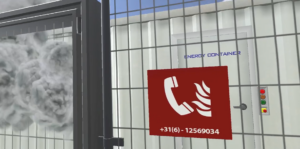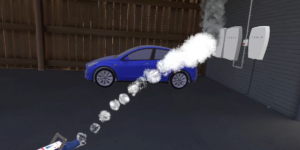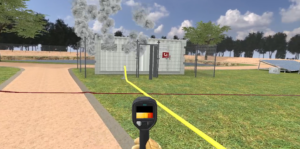In this blog, you will find more about ESS (Energy Storage System) importance, safety and what it stands for. How dangerous and detrimental it can be if it goes on fire. Additionally, the protocols we, at Flashgroup, have incorporated into our fire safety procedures training tool.

Flashover’s Scenario Scene
What Does ESS Stand For?
An Energy Storage System (ESS) is a specific type of power system that integrates a power grid connection. As a result, it serves the purpose of a safety buffer between the electricity generation and the main power grid. It also allows for time-shifting power, charging from solar, providing grid support, and exporting power back to the grid.

Lithium Battery – Electric Mini Vehicle

Lithium Battery – Electric Mini Vehicle

Lithium Battery – Electric Mini Vehicle
How Lithium Battery Fires Can Start?
Equally important, these are the following ways how the lithium battery fire can start ↓
Thermal Runaway:
In fact, when an energy storage system (ESS) with lithium batteries goes on fire, it can be a serious and hazardous event, mainly due to the nature of lithium-ion batteries.
Overcharging:
In the same way, overcharging lithium batteries can lead to excessive voltage, which destabilizes the battery’s chemistry and can lead to overheating and possibly combustion.
Electrical Short-Circuits:
Shorts inside the battery can occur due to manufacturing flaws, degradation over time, or physical damage. A short circuit increases the current flowing through the battery, which can generate excessive heat.

What protocols has Flashover incorporated?
Flashgroup is a company whose core mission is to provide safe training for emergency services professionals, with the increasing usage of ESS, overtaking solar panels, we believe that it is extremely vital to have ESS implemented in our training software. There are all kinds of safety procedures. We have covered the protocols within the firefighting department.
-> The contact during the scenario with the energy power suppliers
-> How to safely handle lithium battery fires
-> IBGS (Hazardous substances incident response) procedures
-> How to recognize a thermal runaway

It is essential to mention that these are just a few examples. Additionally, everything should be executed in the right order. The whole ESS is relevantly new, therefore, the training and protocol are based on theory and few practical examples.

To conclude, our scenarios cover from small ESS to large ESS (from portable ESS on your electric bike to a large ESS system in a solar park).
In summary, fires in lithium battery energy storage systems can be extremely intense and hazardous, requiring specific preventive measures and firefighting techniques.
Our team is aware of that and therefore we focus on implementing ESS importance and safety into our safety training scenarios. Would you like to request a demo? Contact Our Experts.
